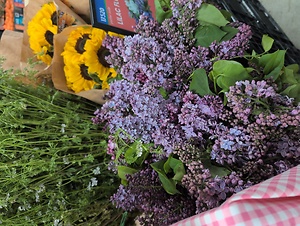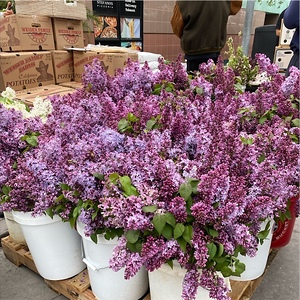


Lilac Flowers
Estimated Inventory, bunch : 0
Description/Taste
Lilac flowers bloom in loose, branching clusters, also known as panicles. These clusters form a conical to pyramidal shape and average 15 to 20 centimeters in length, depending on the variety. Each panicle is comprised of tiny flowers, and the blooms are typically less than three centimeters in diameter. Lilac flowers have a tube-like base that opens to 4 to 5-lobed petals with blunt to pointed ends. The flowers vary in color and can appear in white, lavender, purple, or blue hues. Lilac flowers are soft, delicate, tender, and crisp. The flowers are known for their strong fragrance and are said to smell floral, powdery, green, and sweet. Lilac flowers of the common species are edible raw and have a floral, subtly bitter, and astringent taste. The blooms are often paired with sugar to create a balanced flavoring and are primarily used for their memorable fragrance in culinary dishes.
Seasons/Availability
Lilacs bloom in late spring through early summer. Many species are grown throughout both hemispheres, and each variety has varying bloom times within the above range.
Current Facts
Lilacs, botanically classified as Syringa vulgaris, are a category of plants with fragrant blooms belonging to the Oleaceae family. The flowers grow on deciduous, multi-stemmed shrubs or trees reaching 2 to 6 meters in height and are a favored home garden plant for their ornamental qualities. There are many species of Lilacs worldwide, and the Common Lilac, Syringa vulgaris, is the primary focus of this article. Common Lilacs are also used beyond their ornamental nature as a culinary ingredient and are sometimes known as French or English Lilacs. It is important to note that other species of Lilacs outside of the common species are heavily debated as edible. More research needs to be conducted before conclusions about the other species can be made. Each year, Lilacs only bloom for a few weeks and are treasured as a seasonal gift for their coloring, aroma, and versatility. Chefs and home cooks utilize Lilac flowers in a wide array of sweet and savory culinary preparations, and the flowers are infused into preparations to capture their intoxicating fragrance.
Nutritional Value
Lilac flowers are used in natural medicines as a calming ingredient. The flowers are believed to be a source of antioxidants, which have anti-inflammatory properties and can help strengthen the immune system. The flower’s fresh, sweet scent is also inhaled to soothe the mind, lower stress, and induce relaxation. Lilac flowers are often infused for their aroma into creams, perfumes, and bath products like soaps and sugar scrubs. They have also been used in herbal medicines for digestive and respiratory issues throughout history.
Applications
Lilac flowers have a floral, slightly bitter, and astringent taste suited for fresh and cooked preparations. It is critical that only blooms foraged from clean plants free of pesticides and other chemicals are consumed for culinary purposes. Select opened flowers for recipes and be sure to only use the bloom, discarding the stems and branches. Lilac flowers should be rinsed before use, and once prepped, the blossoms can be sprinkled in salads or used sparingly as an edible garnish. Lilac flowers typically have an astringent taste when raw and are mainly used for their fragrance. The flowers are popularly coated in egg whites and sugar to create a candied bloom, and these intact flowers are displayed on cakes and other desserts. Lilac flowers are also dried and added to sugar for baked goods or incorporated into frostings. Worldwide, Lilac flowers are famously used in springtime desserts. The bloom’s fragrance can be infused into cakes, cookies, scones, donuts, and pavlovas or simmered into custards and puddings. Lilac flowers are also cooked into jellies and syrups, and the syrup is used in beverages like lemonade, mocktails, and cocktails. Try infusing Lilac flowers into water, tea, and wine. Lilac water is said to taste just like the blooms smell and is a refreshing spring drink. The blooms can also be infused into honey. Sugar-filled, Lilac-permeated mixtures can be frozen into homemade popsicles or combined into ice cream with other balancing flavors. The scent of Lilac flowers complements other ingredients like strawberries, blackberries, blueberries, grapefruit, lemon, matcha, vanilla, chocolate, and almond. It is recommended to immediately use the blooms for the best quality and flavor. Lilac flowers can last a few days to one week, depending on their maturity at harvest. The flowers should be stored in a sealed container in the fridge. It is not recommended to freeze the blossoms as they will brown when thawed.
Ethnic/Cultural Info
Common Lilacs acquired their scientific genus, Syringa, from the Greek word “syrinx.” This Greek term roughly translates to “hollow tube or pipe,” a descriptor alluding to the use of Lilac wood for making musical instruments. Lilac wood is not always hollow but contains a soft pulp that can be removed to make flutes. Once dry, the wood also becomes dense and hard, contributing to its use as a durable instrument material. In Greek mythology, the Lilac wood makes the first pipe played by Pan, the Greek god of nature, shepherds, and hunters. Legend says Pan noticed a beautiful nymph named Syrinx or Syringa in the woods one day. Pan began to pursue her romantically, and Syringa transformed into a Lilac tree in her desperation to flee his grasp. Pan took wood from the tree and made it into his pipe, also referred to as a flute. This musical instrument is still closely associated with the god and is commonly played by shepherds.
Geography/History
Lilac flowers are native to Southeastern Europe and parts of Asia and have been growing wild since ancient times. There are several centers of origin, depending on the specific species, and Common Lilacs, or Syringa vulgaris, are thought to have arisen from the Balkan Peninsula. In this region, Lilac plants are found growing in woodlands and rocky hills, and were eventually taken from these native habitats and planted in home gardens. Lilac flowers were once used for funerals as their fragrant scent could mask unfavorable odors. The blooms became associated with death for many years and are still sometimes seen in cemeteries in modern days. Later in the 16th century, Lilac flowers were introduced to the rest of Europe and quickly spread in popularity amongst growers and nurseries in Western Europe. Over time, many new varieties of Lilacs were developed, creating hybrid types with colorful blooms. Lilacs were extensively bred in France, leading to the Common Lilac's other name of French Lilac. In England, Lilacs were initially associated with bad luck and misfortune, but in the Victorian Era in the 19th century, the flowers acquired different meanings of innocence, happiness, love, and passion in the Victorian Language of Flowers. Lilacs traveled to North America in the 18th century and were planted by European settlers. The flowers were frequently recorded by Thomas Jefferson in his garden books, and it is rumored that George Washington also had Lilacs in his garden. Common Lilacs were also chosen as the state flower of New Hampshire in 1919. Today, Lilacs have spread around the world and become a widespread category of multi-colored varieties. Various species are cultivated commercially and in home gardens in Europe, Asia, the Americas, and Australia. For culinary use, Lilac flowers are sold through select farmers’ markets and specialty retailers.
Recipe Ideas
Recipes that include Lilac Flowers. One
| Sweetambs |
|
Lilac Cookie Pops |
| The Practical Herbalist |
|
Lilac Honey |
| The Happy Meal Time |
|
Lilac cupcakes |









